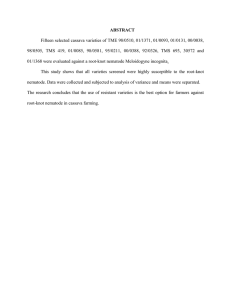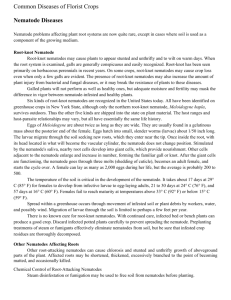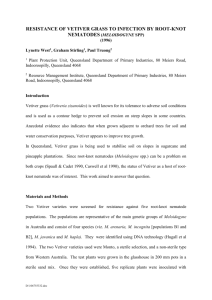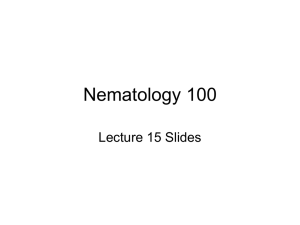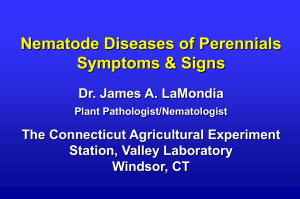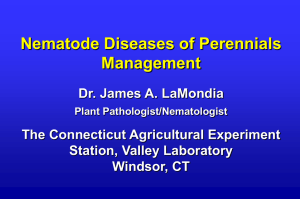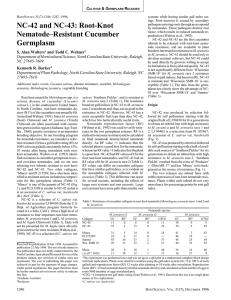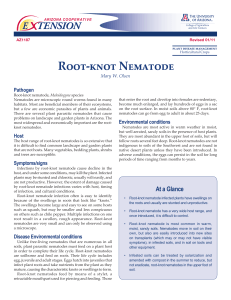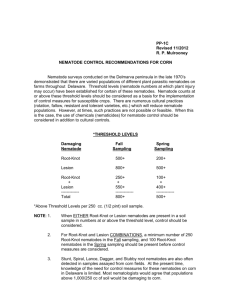Root-knot nematode species identification using mitochondrial DNA
advertisement
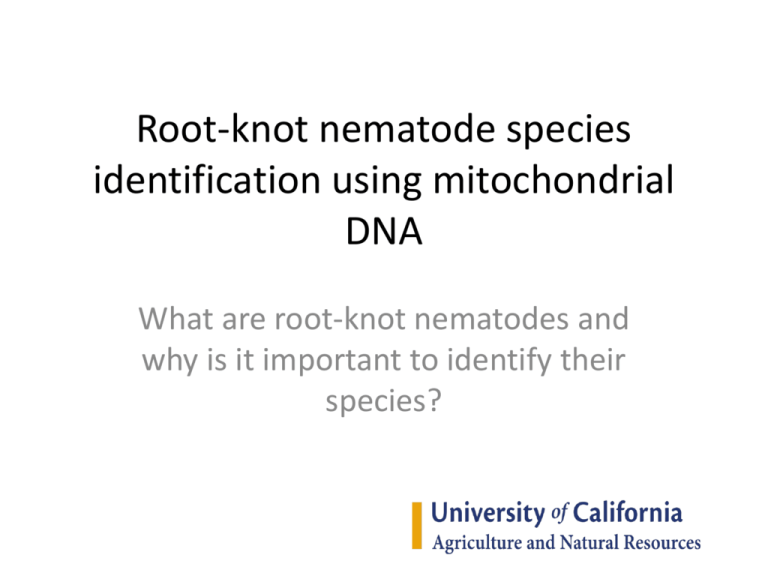
Root-knot nematode species identification using mitochondrial DNA What are root-knot nematodes and why is it important to identify their species? Nematodes (roundworms) are tiny animals “Four out of five animals on earth are nematode worms” – E. O. Wilson free living species, animal parasites, plant parasites Plant parasitic nematodes Estimated average annual yield loss of the world’s major crops due to damage by plant parasitic nematodes is 12.3% Monetary losses due to nematodes exceed $100 billion annually. Almost all are obligate parasites that feed exclusively from the cytoplasm of living plant cells. Diverse group – plant parasitism evolved at least 3 times Root-knot nematodes are generally regarded as the most damaging group Root-knot nematodes Can infect most crops including tomato, melon, prunus, cotton, alfalfa, grape, walnut, peanut, eggplant, wheat, corn, strawberries……. >70 species of Meloidogyne, but the most widespread and damaging are: Meloidogyne incognita, M. javanica, M. arenaria, M. hapla M. javanica infected-tomato roots M. incognita infected carrot DAMAGE (here on tomato) Root knot nematode-infected plants appear less vigorous than healthy plants, may be yellowed, are prone to wilt, and respond poorly to fertilizer. NCSU R.G. Gardner See UC ANR pub #3470 Management of Root-knot Nematodes 1. CHEMICAL FUMIGATION 1,3-DICHLOROPROPENE (Telone) Liquid fumigant for the preplant treatment of soil against plant-parasitic nematodes using drip irrigation systems. Use of a tarp seal is mandatory for all applications of this product. METAM SODIUM (Vapam, Metam Sodium) These fumigants are toxic and a prime source of volatile organic compounds, which are a major air quality issue. Fumigate only as a last resort when other management strategies have not been successful or are not available. See UC ANR pub #3470 Management of Root-knot Nematodes 2. CULTURAL CONTROL Some crop varieties are resistant to nematodes. Rotation with resistant varieties and non-host crops can be almost as effective as fumigation. Cultural control requires accurate identification of the root-knot nematode species present. See UC ANR pub #3470 Nematode resistance in tomato is mediated by a single dominant gene, Mi-1 Resistant (Mi) Susceptible (mi) The Mi-1 gene *Was introduced into cultivated tomato from a wild tomato species in the 1940s at UCD. *Most processing tomato varieties in California have the Mi gene. *Confers effective resistance against several species of root-knot nematode (M. incognita, M. javanica, M. arenaria, but not M. hapla or M. enterolobii). Meloidogyne enterolobii Meloidogyne enterolobii was originally described from a population collected from the pacara earpod tree in China in 1983. In 2001 it was reported for the first time in the continental USA in Florida. It has also been reported in South America, Carribean, Costa Rica, Mexico, Europe, Africa. M. enterolobii is now considered as one of the most important root-knot nematode species because of its ability to reproduce on root-knot nematode-resistant tomato, bell pepper and other economically important crops. -Wikipedia Courtesy: Dr Sebastian Kiewnick, Agroscope Changins-Wädenswil Research Station (CH) The most commonly used methods for diagnostic identification of root-knot nematodes were error-prone and had limitations Morphology/microscopy isozymes M. incognita M. javanica Species-specific primers The most promising diagnostic was PCR with mitochondrial DNA Primers Powers and Harris, J. Nematology 25:1-6 (1993) Root-knot nematode species differ in the length and sequence of an intergenic region of their mitochondrial genome This method can identify the species of single juveniles of RKN This approach was not broadly adapted. Why? http://nematode.unl.edu/diagnostics.htm Scheme to identify root-knot nematodes by mitochondrial DNA PCR Limitations: *Too many steps *Prone to failure *Not all species can be distinguished Powers et al., (2005) J. Nematology 37:226-235. This UC-ANR project: Root-knot nematode species identification using mitochondrial DNA First step was a meeting of collaborators and end users to establish project plan details and desirable end products. Principal investigators; extension nematologist; CDFA scientists; collaborator from UC Riverside. Reliable, robust, validated. Simple, reproducible transferable. Adaptable to different sample types Open ended (can identify new species) We focused on the variable region of the mitochondrial genome 16.5 kb We collected samples of DNA isolated from characterized strains and species of Root-knot Nematodes from different parts of the world USA: M. incognita, M. javanica, M. arenaria, M. hapla (3), M. chitwoodi France: M. arenaria Costa Rica: M. enterolobii Brazil (R. Carneiro): M. arenaria, M. enterolobii, M. incognita (3), M. javanica, M. hapla, M. arabicida, M. ethiopica, M. hispanica, M. inornata, M. izalcoensis, M. morocciensis, M. paranaensis (2), M. petunia, M. exigua We determined the DNA sequence of the variable region of 24 isolates representing 15 different species tRNAHis AT region Intergenic spacer COII l-rRNA C2F2 1108 MORF 1 C2F2 /1108 (1640 bp) MTHIS MORF/MTHIS (743 bp) 743 TRNAH 737 (H-790) MRH106 M -1086 1294 (H-1182) M-1163 TRNAH /MRH106 (557 bp) Based on the sequence data we developed a strategy to distinguish major RKN species undigested MnlI digests HinfI digests 500 bp M Mi Mj VW6 VW4 Ma F Me BR17 Mh VW9 M Mi Mj Ma VW6 VW4 F Me Mh BR17 VW9 M Mi Mj VW6 VW4 Ma F Me Mh BR17 VW9 Key to species identification based on Mitochondrial DNA patterns of characterized strains Pattern F1 uncut F1 Hinf1 F1 Mnl1 F2 uncut A 556 445,112 340,140 214 arenaria, morocciensis B 556 396,112 340, 217 743 incognita B’ 556 396,112 340, 217 636 incognita V1 C/H 556 445,112 417,140 743 arenaria V1 D 556 556 340, 140 743 javanica G 556 445,112 340, 140 743 arenaria V2, ethiopica, hispanica, inornata, petunia K 723 723 583, 140 NP enterolobii Species The following species produced patterns that did not match any of the above: M. arabicida, M. chitwoodi, M. exigua, M. hapla, M. izalcoensis, M. paranaensis Our protocol can reliably identify the species of major nematode species from a range of sample types males juveniles females egg masses collected from African field isolates, preserved in ethanol, and shipped to California Root pieces picture from: Castagnone-Sereno, Heredity (2006) Species identification of samples from Africa country # of samples A B (Mi) C/H D (Mj) G K (Me) novel Tanzania 15 1 3 0 11 0 0 0 Kenya 15 1 7 0 5 0 0 2 Nigeria 50 0 36 0 5 0 9 0 Benin 23 0 7 0 4 3 8 0 Hap B (M. incognita) and G (M. javanica) were most common. Hap K (M. enterolobii) was found in W. Africa, but not E. Africa. Two samples from Kenya showed novel pattern intermediate between M. incognita and M. arenaria Summary points Our assay is robust, easy and can distinguish all the common RKN species found in California. Our assay easily detects Meloidogyne enterolobii. Our assay can be applied to ethanol-preserved egg masses (or females). DNA sequence of the amplified region can provide information on new, uncommon or invasive species. Nematode barcode (courtesy Mark Blaxter) These findings have been published in Pagan et al. (2015) Phytopathology Credits Research team: Valerie Williamson, UCD, PI Steve Nadler, UCD, Co-PI Chris Pagan, UCD, Junior Specialist Collaborators: Becky Westerdahl, UCD, Extension Nematologist Ke Dong, Pest Diagnostics Branch, CDFA Sergei Subbotin, Pest Diagnostics Branch, CDFA Brad Hyman, UCR, Biology Provided DNA samples: Regina Carneiro, Embrapa, BRAZIL; J. Starr, Texas; A. Elling, Washington State; D. Humphries, Costa Rica; L. Zuretto, France Samples from Africa: Danny Coyne, IITA, George Kariuki, Kenyatta Univ.
